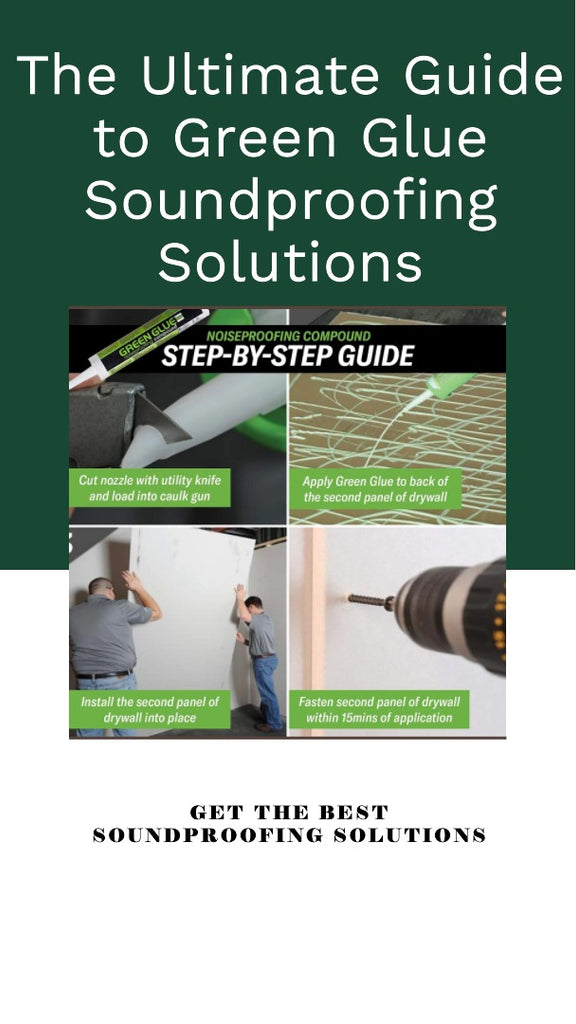Award Winning Service
Award Winning Service

Superior noise reduction in residential and commercial spaces is a critical aspect of creating comfortable and productive environments. Green Glue is an innovative soundproofing solution that has gained popularity due to its effectiveness and ease of use. In this ultimate guide, we delve into the world of Green Glue soundproofing, investigating the various product types, applications, installation methods, and frequently asked questions. By the end of this guide, you'll have a better understanding of how to use Green Glue to create quieter and more enjoyable spaces.
Before we dive into the benefits and applications of Green Glue, it's essential to understand how sound travels. Sound transmission occurs through two primary pathways:
Soundproofing materials and solutions absorb or block sound waves seek to reduce both airborne and impact noise. Green Glue is intended to be an effective solution for reducing both types of noise transmission.
Green Glue Noiseproofing Compound is a viscoelastic material that converts sound waves into heat energy and thus reduces noise transmission between surfaces. The key benefits of Green Glue include:
Green Glue Noiseproofing Compound can be used for a variety of purposes, including:
Follow these application steps to achieve the best possible soundproofing results with Green Glue:
Easy unboxing, set up, and application of Green Glue Compound.
Green Glue Acoustic Sealant is an essential part of any soundproofing project. This sealant prevents sound leakage by filling gaps, cracks, and seams in your walls, ceilings, and floors. To use Green Glue Acoustic Sealant effectively:

Apply Green Glue Acoustic Sealant along the edges and seams of the drywall.
Q: How long does Green Glue take to reach its maximum effectiveness?
A: It usually takes 30 days for Green Glue Noiseproofing Compound to reach its peak soundproofing performance. While you may notice an immediate improvement, the compound's performance will improve over time.
Q: Can I paint or apply wallpaper over Green Glue?
A: Yes, once the Green Glue Noiseproofing Compound has fully cured, you can paint or apply wallpaper to the surface as you would any other standard drywall surface.
Q: Is Green Glue safe to use in my home?
A: Green Glue is a low-VOC product and is safe for use in residential and commercial spaces. It's essential to follow the manufacturer's safety guidelines and instructions during application and ensure proper ventilation.
Q: Can Green Glue be combined with other soundproofing methods?
A: Yes, Green Glue can be combined with other soundproofing techniques such as resilient channels, resilient sound isolation clips, insulation, and mass loaded vinyl. Using Green Glue in conjunction with these methods can result in even greater sound reduction.
Q: How much Green Glue Compound do I need for my project?
A: The amount of Green Glue Compound required depends on the size of your project. Each tube of Green Glue covers approximately 16-24 square feet. To calculate the number of tubes needed, divide the total square footage of your project by the coverage per tube.
Q: How much STC improvement can I expect from using Green Glue?
A: Green Glue can significantly improve a wall, ceiling, or floor assembly's Sound Transmission Class (STC). The exact improvement depends on the specific construction and materials used, but when Green Glue is applied correctly, it is common to see an increase of 7-10 STC points or more.
Q: How much Green Glue Sealant do I need compared to Green Glue Compound?
A: The quantity of Green Glue Sealant required is determined by the size and complexity of your project. Sealant is commonly used to fill gaps, cracks, and seams in drywall, as well as around electrical outlets, pipes, and other openings. The amount of coverage per tube of Green Glue Sealant varies according to the size of the gaps to be sealed. In general, one tube of Green Glue Sealant with a 1/4-inch bead can cover approximately 50 linear feet. To estimate the number of tubes required, multiply the total linear footage of gaps to be sealed by the coverage per tube. Keep in mind that this is not the same as the Green Glue Compound that is used between drywall layers..
Green Glue Noiseproofing Compound is an effective and versatile solution for reducing sound transmission in walls, ceilings, and floors. By following our comprehensive guide, you can achieve professional-grade soundproofing results in your residential or commercial space. Green Glue is an excellent choice for creating a quieter, more comfortable environment, whether you are a DIY enthusiast or a professional contractor.

{"one"=>"Select 2 or 3 items to compare", "other"=>"{{ count }} of 3 items selected"}
Comments
Leave a comment